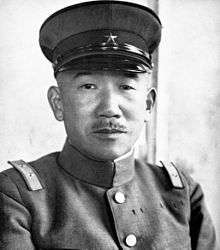Jun Ushiroku
| Jun Ushiroku | |
|---|---|
 General Jun Ushiroku | |
| Born |
September 28, 1884 Kyoto prefecture, Japan |
| Died | November 24, 1973 (aged 89) |
| Allegiance | Empire of Japan |
| Service/ |
|
| Years of service | 1905 - 1945 |
| Rank | General |
| Commands held |
26th Division Fourth Army Southern China Area Army Third Area Army |
| Battles/wars |
Siberian Intervention Second Sino-Japanese War World War II |
| Awards |
Order of the Sacred Treasures (1st class) Order of the Golden Kite (2nd class) Order of the Rising Sun (1st class) |
| Other work | Minister of War |
Jun Ushiroku (後宮 淳 Ushiroku Jun, 28 September 1884 – 24 November 1973) was a general in the Imperial Japanese Army.
Biography
A native of Kyoto prefecture, Ushiroku graduated from the 17th class of the Imperial Japanese Army Academy in 1905. He served in combat very briefly at the very end of the Russo-Japanese War. He graduated from the 29th class of the Army War College (Japan) in 1917. He served with Japanese forces in the Siberian Intervention of 1919 in support of White Russian forces against the Bolshevik Red Army.
Ushiroku was posted to the Kwantung Army in Manchuria in December 1925, and was assigned to the protection of the South Manchurian Railway. Promoted to colonel in 1929, he became commander of the IJA 48th Infantry Regiment. In August 1931, he was reassigned as Chief of Staff of the IJA 4th Division.
From 1932-1938, Ushiroku served in a number of staff positions within the Kwantung Army headquarters in Manchukuo. He was promoted to major general in March 1934 and to lieutenant general in August 1937. In October of the same year, he became commander in chief of the IJA 26th Division, which was active in the Second Sino-Japanese War.[1]
Ushiroku was promoted to commander in chief of the IJA 4th Army from 1939–1940 and served as commander in chief of the Southern China Area Army from 1940–1941 and as chief of staff of the China Expeditionary Army from 1941-1942. From 1942-1943, Ushiroku was commander in chief of the Central District Army from August 1942 to February 1944[2]
In 1944, he became Vice Chief of the Imperial Japanese Army General Staff for some months in 1944[3] during his time he was also a member of the Supreme War Council (Japan) and, Inspector-General of Army Aviation and Chief of the Army Aeronautical Department within the Ministry of War. In these roles, he strongly pushed for the use of suicide attacks by infantry to disable or destroy American armor due to Japan's inability to mass-produce effective anti-tank weapons at this stage of the war.[4]
Towards the end of the war, Ushiroku returned to Manchukuo to take command of the Japanese Third Area Army to oppose the Soviet invasion. He refused orders to retreat, and launched a counterattack along the Mukden-Port Arthur railway, along which many Japanese civilians were fleeing. By 13 August 1945, his formations were largely shattered, and a mutiny by the Manchukuo Imperial Army at Shinkyō ended his attempts to regroup. He surrendered to the Soviet army on 21 August 1945. He spent more than a decade as an internee in the Soviet Union. Uchiroku returned to Japan on 26 December 1956.
Ushiroku served as Chairman of the Japan Veterans Association until his death in 1973. His grave is at the Tama Cemetery in Fuchu, Tokyo.
References
Books
- Fuller, Richard (1992). Shokan: Hirohito's Samurai. London: Arms and Armor. ISBN 1-85409-151-4.
- Hayashi, Saburo; Cox, Alvin D (1959). Kogun: The Japanese Army in the Pacific War. Quantico, VA: The Marine Corps Association.
External links
- Ammenthorp, Steen. "Ushiroku, Jun". The Generals of World War II.
- Budge, Kent. "Ushiroku, Jun". Pacific War Online Encyclopedia.
- Chen, Peter. "Ushiroku, Jun". WW2 Database.
Notes
- ↑ Ammenthorp, The Generals of World War II
- ↑ Axis History Factbook: Central District Army (Japan)
- ↑ Axis History Factbook: Army General Staff (Japan)
- ↑ Chen, WW2 Database